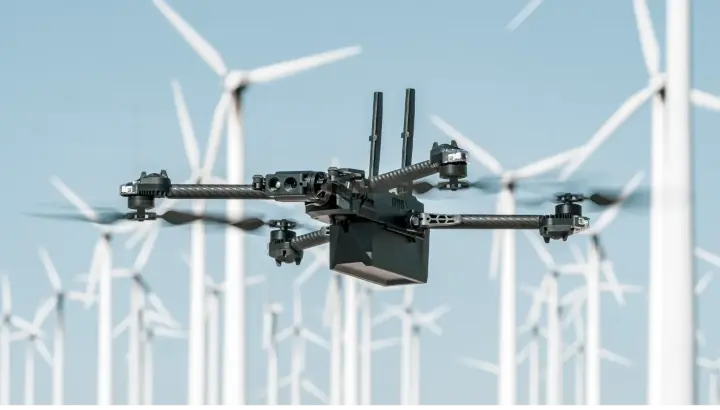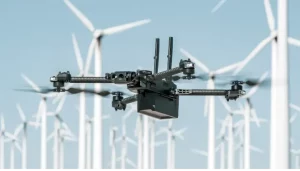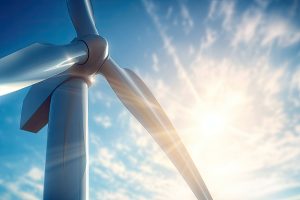How Drones Are Being Used For Wind Turbine Inspections: Wind energy has emerged as a cornerstone of the global transition towards sustainable power generation.
Wind turbines, the towering structures that harness the power of wind, have become an increasingly familiar sight across landscapes across the globe.
Yet, ensuring the optimal performance and longevity of these giant structures of renewable energy requires regular and thorough inspections.
Traditional inspection methods, involving rope access or crane usage, can be time-consuming, costly, and pose significant safety risks to technicians.
In the last few years, the introduction of unmanned aerial vehicles (UAVs), more commonly recognized as drones, has completely transformed the panorama of inspecting wind turbines.
The inspection of wind turbines using drones presents a safer, notably more effective, and economically viable substitute for conventional approaches, reshaping the manner in which operators of wind energy uphold their valuable assets.
Read on to learn more.
Using Wind Turbine Drones Enhances Inspection Safety And Efficiency
Wind turbine drone inspection eliminates the need for technicians to scale the towering structures, significantly reducing the risk of falls and other work-related accidents.
Drones can effortlessly discover the complicated makes of wind turbines, as well as capture high-resolution images and videos from angles and vantage points that would be inaccessible to human inspectors.
This comprehensive visual data allows for detailed assessments of the turbine’s components, enabling early detection of potential defects or damage.
The speed of wind turbine drone inspections further enhances safety and efficiency.
A single drone can inspect an entire wind turbine in a matter of minutes, compared to the hours or even days required for traditional methods.
This rapid assessment capability minimizes downtime for wind turbines, maximizing their energy production and profitability.
Wind Turbine Drone Inspections Reduce Costs And Boost Reliability
It’s believed that the cost savings associated with wind turbine drone inspections are substantial.
By eliminating the need for specialized equipment, such as cranes or rope access systems, drone-based inspections significantly reduce operational expenses.
Additionally, the ability to detect minor issues early on prevents the escalation of more serious problems that could lead to costly repairs or replacements of damaged parts.
In addition, the comprehensive data gathered during wind turbine drone inspections plays a crucial role in predictive maintenance strategies.
By analyzing historical inspection data and identifying patterns of wear or potential failure points, wind energy operators can proactively schedule maintenance interventions, preventing unexpected breakdowns and ensuring the long-term reliability of their wind turbines.
Wind Turbine Drones Expand Conventional Inspection Capabilities
The versatility of drones extends beyond the usual visual inspections.
Equipped with specialized sensors, drones can conduct thermal imaging inspections, detecting temperature variations that indicate potential electrical issues, overheating components, or structural defects.
This capability provides valuable insights into the internal health of wind turbines, enabling preventive measures before issues escalate.
Furthermore, drones can be equipped with ultrasonic sensors to detect internal cracks or delamination in wind turbine blades.
These sensors emit sound waves that penetrate the blades’ material, revealing abnormalities that may not be visible to the naked eye.
This technology offers a non-destructive method for assessing blade integrity, reducing the need for more invasive inspection techniques and allowing for the replacement of defective parts early on.
Drones For Wind Turbine Upkeep: The Future Of Wind Turbine Maintenance
The adoption of wind turbine drone inspections is rapidly expanding as the technology matures and its benefits become increasingly evident.
Wind energy operators worldwide are recognizing the safety, efficiency, and cost-saving advantages of drone-based inspections, integrating them into their maintenance protocols.
As drone technology continues to evolve, the capabilities of wind turbine inspections will expand even further.
Advancements in artificial intelligence (AI) and machine learning will enable drones to autonomously analyze inspection data, providing real-time insights and recommendations to wind energy operators.
This intelligent approach will further streamline maintenance processes and optimize wind turbine performance.
Wind turbine drone inspections represent a transformative step forward in wind energy maintenance.
By harnessing the power of UAV technology, wind energy operators can ensure the safety, efficiency, and reliability of their assets, maximizing their contribution to a sustainable energy future.
Environmental Benefits Of Wind Turbine Drone Inspections
In addition to their economic advantages, wind turbine drone inspections also offer significant environmental benefits.
These benefits stem from the reduced reliance on fossil fuels and the minimization of waste generated during maintenance activities.
-
Reduced Reliance On Fossil Fuel Use
Traditional wind turbine inspection methods often rely on fossil fuel-powered equipment, such as cranes or trucks, contributing to greenhouse gas emissions.
Wind turbine drone inspections, on the other hand, utilize electric-powered drones, significantly reducing the carbon footprint associated with maintenance activities.
-
Minimized Waste Generation
Rope access and crane-based inspection methods often generate waste materials, such as discarded ropes, slings, or scaffolding components.
Wind turbine drone inspections, being non-invasive and requiring minimal physical intervention, minimize the generation of waste, contributing to a cleaner and more sustainable maintenance approach.
-
Better Promotion Of Sustainable Energy Production
By enhancing the efficiency, safety, and reliability of wind energy operations, wind turbine drone inspections promote the growth and sustainability of the wind energy industry.
As wind energy becomes a more prominent source of renewable power, the environmental benefits of drone-based inspections will extend to the broader energy landscape.
In Conclusion
Wind turbine drone inspections offer a multifaceted approach to wind turbine maintenance, providing economic, environmental, and operational advantages that are transforming the wind energy industry.
As technology continues to mature and its benefits become increasingly recognized, wind turbine drone inspections are poised to play a pivotal role in the transition towards a sustainable energy future.




